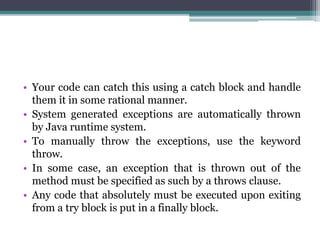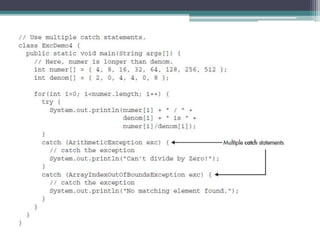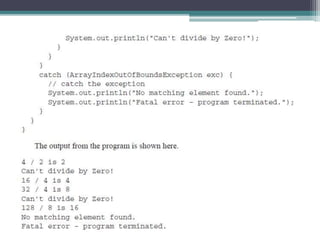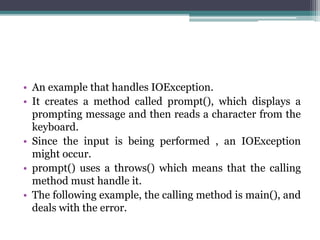Ad
Java-Unit 3- Chap2 exception handling
- 2. contents • The exception hierarchy • Exception handling fundamentals • Try and catch • The consequences of an uncaught exception • Using multiple catch statements • Catching subclass exceptions • Nested try blocks • Throwing an exception • Re-throwing an exception • Using finally • Using throws • Java’s built-in exception • Creating exception subclasses
- 3. introduction • A exception is an error that occurs at run time. • An advantage of exception handling is that it automates much of error handling code that previously had to entered “by hand” into large program. • Exception handling streamlines error handling by allowing your program to define a block of code called an exception handler, I.e. executed automatically when an error occurs. • It is not necessary to manually check the success or failure of each specific operation or method call. • If an error occurs, it will be processed by the exception handler.
- 4. • Another reason that exception handling is important is that java standard exceptions for common program errors, such as divide-by-zero or file or not found. • To respond to these errors , your programs must watch for and handle these exceptions. • To be a successful Java programmer means that you are fully capable of navigating Java’s exception handling subsystem.
- 5. The Exception Hierarchy • In Java, all exceptions are represented by classes. • All exception classes are derived from a class called Throwable. • When an exception occurs in a program, an object of some type of exception class is generated. • There are two direct subclasses of Throwable: Exception and Error • Exceptions of the type Error are related to the errors that occur in Java Virtual machine itself and not in your program. • These exceptions are usually beyond your control, your program will not usually deal with them.
- 6. • Errors that result from program activity are represented by subclasses of Exceptions. • For example: divide- by-zero , array boundary , file errors fall into this category. • An important subclass of Exception is RuntimeException , which is used to represent various common types of run-time errors.
- 7. Exception handling fundamentals • Java Exception handling has five keywords: ▫ try ▫ catch ▫ throw ▫ Throws ▫ finally • Program statements that you want to monitor for exceptions are contained within a try block. • If an exception occurs within the try block , it is thrown
- 8. • Your code can catch this using a catch block and handle them it in some rational manner. • System generated exceptions are automatically thrown by Java runtime system. • To manually throw the exceptions, use the keyword throw. • In some case, an exception that is thrown out of the method must be specified as such by a throws clause. • Any code that absolutely must be executed upon exiting from a try block is put in a finally block.
- 9. Using try and catch • These keywords work together; • you can’t have a try without a catch, or catch without a try try { // block of code to monitor for errors } catch (ExcepType1 exOb) { // handler for ExcepType1 } catch (ExcepType2 exOb) { // handler for ExcepType2 }...
- 10. • Here, ExcepType is the type of exception that has occurred. • When an exception is thrown, it is caught by its corresponding catch statement, which then processes the exception. • As the general form shows, there can be more than one catch statement associated with a try. • The type of the exception determines which catch statement is executed. • When an exception is caught, exOb will receive its value. • Here is an important point: If no exception is thrown, then a try block ends normally, and all of its catch statements are bypassed. Execution resumes with the first statement following the last catch. • Thus, catch statements are executed only if an exception is thrown.
- 11. A simple exception example • An error to attempt to index an array beyond its boundaries. • When this occurs, the JVM throws an ArrayIndexOutOfBoundsException.
- 12. • This program displays the following output: Before exception is generated. Index out-of-bounds! After catch statement. • the code that you want to monitor for errors is contained within a try block. • when an exception occurs the exception is thrown out of the try block and caught by the catch statement. • After the catch statement executes, program control continues with the statements following the catch. • it is the job of your exception handler to remedy the problem that caused the exception so that program execution can continue normally. • if no exception is thrown by a try block, no catch statements will be executed and program control resumes after the catch statement
- 13. The consequences of an Uncaught Exception • By having an exception handler, it prevents abnormal program termination. • If your program does not catch an exception, then it will be caught by the JVM. • JVM exception handler terminates the execution and displays a stack trace and error message.
- 14. // This won't work! class ExcTypeMismatch { public static void main(String args[]) { int nums[] = new int[4]; try { System.out.println("Before exception is generated."); // generate an index out-of-bounds exception nums[7] = 10; System.out.println("this won't be displayed"); } /* Can't catch an array boundary error with an ArithmeticException. */ catch (ArithmeticException exc) { // catch the exception System.out.println("Index out-of-bounds!"); } System.out.println("After catch statement."); } }
- 16. Exceptions enable you to handle errors gracefully • By having an exception handler ,it enables your program to respond to an error and then continue running. • If a division by zero occurs, an ArithmeticException is generated. • In the following program, this exception us handled by reporting the error then continuing with the execution. • Thus attempting to divide by zero does not cause an abrupt run-time error resulting a termination of the program.
- 18. • Makes another important point, once an exception has been handled, it is removed for the system. • In program , each pass through the loop enters the try block new, any prior exception have been handled. • This enables your program to handle repeated errors.
- 19. Using multiple catch statements • We can associate more than one catch statement with a try. • Each catch must catch a different type of exception. • Program that catch both array boundary and divide by zero errors
- 22. Catching subclass exceptions • A catch clause for a superclass will also match any of its subclasses. • Superclass of all exceptions is Throwable , to catch all possible exceptions. • If you want to catch exceptions of both superclass type and a subclass type put the subclass first in the catch sequence. • If you don’t then the superclass catch will also catch all derived classes.
- 23. • Putting the super class first causes unreachable code to be created, since the subclass catch clause can never execute. • In java, unreachable code is an error.
- 25. output
- 26. Nested Try blocks • One try block can be nested within another. • An exception generated within inner try block that is not caught by the catch block associated with the try propagated to the outer try block • Ex: ArrayIndecOutOfBoundException is not caught by the inner catch , but the outer catch
- 29. Throwing an exception • It is possible to throw an exception by using throw statement. • General statement is: ▫ throw exceptObj; • Here the exceptObj should be an object of exception class derived from Throwable. • An example that illustrates the throw statement by manually throwing an ArithmeticException
- 31. Rethrowing an exception • An exception caught by one catch statement can be rethrown so that it can be caught by an outer catch. • It allows multiple handlers access to the exception. • When you rethrow an exception, it will not be recaught by the same catch statement. • It will propagate to the next catch statement.
- 33. class RethrowDemo { public static void main(String args[]) { try { Rethrow.genException(); } catch(ArrayIndexOutOfBoundsException exc) { // recatch exception System.out.println("Fatal error – " + "program terminated."); } } }
- 34. Closer look at Throwable class
- 35. Using finally • When you want to define a block of code that will execute when a try/catch block is left. • A method that has opened a file or a network connection that needs to be closed. • To specify a block of code to execute when a try/catch block is exited, included a finally block at the end of try/catch sequence. • General form of try/catch that includes finally is as shown below.
- 37. • The finally block will be executed whenever execution leaves a try/catch block, no matter what condition causes it. • i.e. whether try block ends normally or because of an exception, last code that will be executed is defined by finally. • Example of using the concept of finally
- 39. class FinallyDemo { public static void main(String args[]) { for(int i=0; i < 3; i++) { UseFinally.genException(i); System.out.println(); } } }
- 40. • Here is the output produced by the program. Receiving 0 Can't divide by Zero! Leaving try. Receiving 1 No matching element found. Leaving try. Receiving 2 Leaving try.
- 41. Using throws • If a method generates an exception that it does not handle, it must declare that exception in throws clause. ret_type methname(param_list) throws excp_list{ //body } ▫ here excp_list is a comma sepearted list of exceptions that the method might throw outside of itself. ▫ When performing keyboard input, you should add the clause throws java.IOException
- 42. • An example that handles IOException. • It creates a method called prompt(), which displays a prompting message and then reads a character from the keyboard. • Since the input is being performed , an IOException might occur. • prompt() uses a throws() which means that the calling method must handle it. • The following example, the calling method is main(), and deals with the error.
- 44. Java built-in exceptions • Inside standard package java.lang , Java defines several exception classes. • There are two kinds of exceptions • Checked exceptions ▫ The exceptions defined by java.lang that must be included in a methods throws list if that method can generate one of these exceptions and does not handle it itself. • Unchecked exceptions ▫ if the compiler does not check to see if a method handles or throws these exceptions.
- 47. Creating Exception subclasses • Creating an exception is easy • Just define a subclass of exception class. • This subclass need not implement anything, it inherits those methods provided by Throwable class. • Exception called NonIntResultException , which is generated when the result of dividing two integer values produce a result with a fractional and override of the toString() method, allowing the description to be printed using println() method.













![// This won't work!
class ExcTypeMismatch {
public static void main(String args[]) {
int nums[] = new int[4];
try {
System.out.println("Before exception is generated.");
// generate an index out-of-bounds exception
nums[7] = 10;
System.out.println("this won't be displayed");
}
/* Can't catch an array boundary error with an
ArithmeticException. */
catch (ArithmeticException exc) {
// catch the exception
System.out.println("Index out-of-bounds!");
}
System.out.println("After catch statement.");
}
}](https://image.slidesharecdn.com/chap2exceptionhandling-150907042031-lva1-app6892/85/Java-Unit-3-Chap2-exception-handling-14-320.jpg)


















![class RethrowDemo {
public static void main(String args[]) {
try {
Rethrow.genException();
}
catch(ArrayIndexOutOfBoundsException exc) {
// recatch exception
System.out.println("Fatal error – " +
"program terminated.");
}
}
}](https://image.slidesharecdn.com/chap2exceptionhandling-150907042031-lva1-app6892/85/Java-Unit-3-Chap2-exception-handling-33-320.jpg)





![class FinallyDemo {
public static void main(String args[]) {
for(int i=0; i < 3; i++) {
UseFinally.genException(i);
System.out.println();
}
}
}](https://image.slidesharecdn.com/chap2exceptionhandling-150907042031-lva1-app6892/85/Java-Unit-3-Chap2-exception-handling-39-320.jpg)


































































































